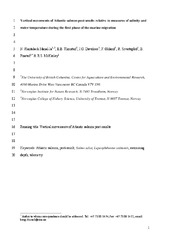Vertical movements of Atlantic salmon postsmolts relative to measures of salinity and water temperature during the first phase of the marine migration
Permanent lenke
https://hdl.handle.net/10037/2015Dato
2009Type
Journal articleTidsskriftartikkel
Peer reviewed
Forfatter
Davidsen, Jan Grimsrud; Plantalech Manel-la, Nuria; Thorstad, E.B; Økland, F.; Sivertsgård, Rolf; McKinley, R.S; Finstad, B.Sammendrag
The migratory behaviour of hatchery-reared Atlantic salmon, Salmo salar L., post-smolts during the
first phase of the marine migration was examined to assess their susceptibility to salmon lice, Lepeophtheirus
salmonis (Krøyer), infestations. Swimming depths of eight post-smolts relative to the measured salinity and
temperature were monitored for an average of 11.4 h following release outside the mouth of the River Eio using
depth sensitive acoustic transmitters. Vertical salinity and temperature distributions were simultaneously recorded
along the migratory route. Mean swimming depth was 1.7 m (individual mean 0.5–2.1 m). There was no overall
preference among all the post-smolts for specific salinity concentrations. Typically post-smolts migrated the
majority (68%) of their time at salinities <20 psu (brackish water), and as a result outside the reported salinity
tolerances of sea lice. Furthermore, post-smolts chose the warmest water layer during their coastal migration.
Beskrivelse
This is the final draft post refereeing version of the article. Published version available at http://dx.doi.org/10.1111/j.1365-2400.2009.00658.x


 English
English norsk
norsk